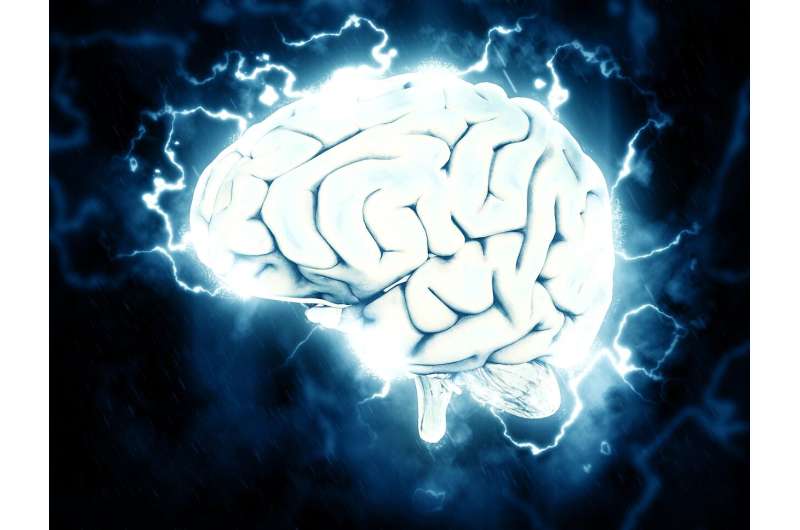Combining brain stimulation with speech therapy shows promise for restoring language in primary progressive aphasia


Primary progressive aphasia is a neurological condition that causes a gradual decline in language abilities. There is no cure or medication that can reverse or stop the progression of PPA. The standard practice in the clinical setting is speech-language therapy to help people with PPA maintain their ability to communicate.
University of Arizona neuroscientists have come up with a new treatment approach for PPA that combines traditional speech therapy with noninvasive electrical stimulation of the brain. The technique—called transcranial direct current stimulation—uses a low electrical current applied through electrodes on the scalp.
A new study published in the Journal of Speech, Language, and Hearing Research describes the treatment approach, which the researchers found to be more effective at managing PPA compared to speech therapy alone.
“Primary progressive aphasia is a condition that causes worsening of communication skills over time. It was identified in the literature only in the last three to four decades, so it is considered pretty new in the health care world—it’s still an understudied area,” said Katlyn Nickels, the study’s lead researcher and a postdoctoral researcher in the U of A Department of Speech, Language and Hearing Sciences.
While writing and speaking words, people don’t just retrieve their meaning. They also retrieve the sound of a word while it is being spoken or written, said Aneta Kielar, the study’s senior author and an associate professor in the Department of Speech, Language and Hearing Sciences.
If there is a problem with associating words with the way they sound, it is difficult to put letters together and speak or write a word, Kielar said. This affects people’s communication in their day-to-day life and their ability to work. For their study, the researchers focused on a type of PPA called the logopenic PPA, in which people have trouble finding the right words and repeating phrases or sentences.
The researchers did neuroimaging analysis of the brain to determine the area of the brain that needs to be stimulated, as people with PPA have brain atrophy or a loss of brain cells.
“We wanted to stimulate the area that is most responsive to language and were careful not to stimulate an area that would have been atrophied already,” Kielar said.
Twelve individuals with written language deficits each received two phases of treatment: in one phase, they got speech therapy paired with active transcranial direct current stimulation. In another phase, they received the same speech therapy with placebo transcranial direct current stimulation. The order of the phases was randomized and separated by a two-month break in between.
Although all participants improved after both treatments, they showed greater and more lasting improvement following the phase with active transcranial direct current stimulation compared to placebo transcranial direct current stimulation.
“People who made numerous spelling errors and struggled to frame complete sentences before the treatment were able to form sentences that were grammatically correct, had fewer spelling errors and were more meaningful after treatment,” Kielar said.
The researchers say brain stimulation helped induce neuroplasticity, the brain’s capacity to continue to reorganize and learn. And it boosted the effects of speech therapy.
“What that means is that brain stimulation can induce the formation of synapses, the connections between neurons. These connections are important for people’s ability to learn and maintain new skills,” Kielar said.
In the future, the research group is planning to look at the genetic, cognitive and neural markers that influence the recovery from PPA. The researchers’ long-term goal is to translate their research findings to a clinical setting.
Because transcranial direct current stimulation is inexpensive, safe and easy to perform, the barriers to implementing it in clinical practice are less significant, Nickels said.
“There’s a misconception sometimes with neurodegenerative diseases, that once you get a diagnosis, there is nothing that can be done,” Nickels said. “But we have learned through our research that even when there’s a progressive brain disease, we can help restore lost function and even slow down the progression.”
More information:
Katlyn Nickels et al, Addressing Phonological Deficit in Primary Progressive Aphasia With Behavioral Intervention and Transcranial Direct Current Stimulation, Journal of Speech, Language, and Hearing Research (2025). DOI: 10.1044/2024_JSLHR-24-00250
Citation:
Combining brain stimulation with speech therapy shows promise for restoring language in primary progressive aphasia (2025, April 21)
retrieved 21 April 2025
from https://medicalxpress.com/news/2025-04-combining-brain-speech-therapy-language.html
This document is subject to copyright. Apart from any fair dealing for the purpose of private study or research, no
part may be reproduced without the written permission. The content is provided for information purposes only.
If you liked the article, do not forget to share it with your friends. Follow us on Google News too, click on the star and choose us from your favorites.
If you want to read more Like this articles, you can visit our Science category.